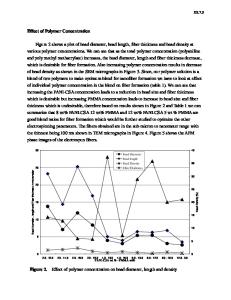Fabrication and Characterization of Molybdenum Oxide Nanofibers by Electrospinning
- PDF / 398,391 Bytes
- 6 Pages / 612 x 792 pts (letter) Page_size
- 38 Downloads / 444 Views
0900-O03-22.1
Fabrication and Characterization of Molybdenum Oxide Nanofibers by Electrospinning Guan Wang1, Xianrong Huang1, Michael Dudley1, Pelagia-Irene Gouma1, Xiaoqing Yang2 1 Department of Materials Science and Engineering, Stony Brook University, Stony Brook, NY 11790, USA 2 Brookhaven National Laboratory, Upton, NY 11973-5000, USA ABSTRACT Molybdenum oxide/ Poly (ethylene oxide) composite nanofibers were prepared by combining the sol-gel process and electrspinning technique. An ethanol solution of Poly(ethylene oxide) (PEO) was mixed with molybdenum isopropoxide to form a precursor solution. Composite nanofibers were obtained by electrspinning this viscous solution. By calcination of the composite fibers, pure
molybdenum oxide nanofibers and nano-rods were obtained with diameters of 100-nanometer scale. Morphology of the fibers has been characterized by scanning electric microscopy. Components and structures of the final products have been identified by EDAX and grazing incidence XRD. Calcination process has been studied by DSC and TG analysis. The real time dynamics of the structural evolution from composite fibers to nanocrystalline metal oxide fibers has been investigated by synchrotron-based in-situ x-ray diffraction. INTRODUCTION Over the past few years, one-dimensional (1 D) nanostructures such as wires, rods, belts and tubes have become the focus of intensive research because of the importance of understanding dimensionally confined transport phenomena and fabrication of nanodevices and nanosensors [1-4]. Many fascinating properties have been proposed or demonstrated for this class of materials, such as higher luminescence efficiency [5, 6], enhancement of thermoelectric figure of merit [7] and a lowered lasing threshold [8]. Molybdenum oxide is long-time known catalyst and possesses photochromic and electrochromic effects [9-14]. These effects are bound up to the features that makes a material sensible to gases [15-20] by modifying the surface conduction bands due to a change in the number of free electrons when a gas molecule interacts with a surface layer. However, studies on nanoscaled molybdenum oxides were comparatively rare because of lack of proper preparation methods for such materials. Electrospinning represents a relatively simple and versatile method for generating fibular mesostructures [21-24]. Typically, a viscous solution composed of polymer and inorganic sol-gel solutions is injected from a small nozzle under the influence of an electric field as strong as several kV/cm. The build up of electrostatic charges on the surface of a liquid droplet induces the formation of a jet, which is subsequently stretched to form a continuous ultra thin fiber. We can obtain a non-woven mats composed of the inorganic/polymer hybrid nanofibers and characterized by high surface area and small pore size. Subsequent calcination process removes the polymer template, leaving oxide fibers behind without destructing the fiber morphology due to the crystallization of the metal oxides at elevated temperatures
Data Loading...










